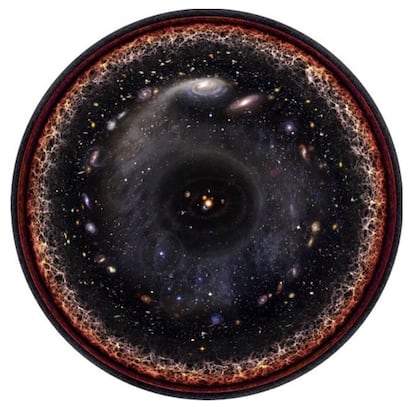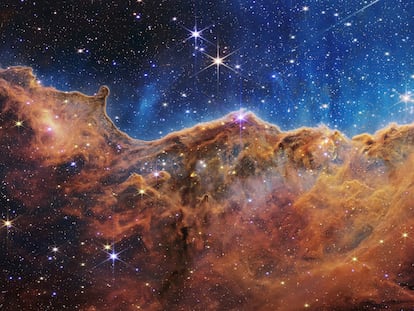What are the limits of our universe?
The universe may be infinite, but there are boundaries we will never be able to cross and places we will never reach, even if we moved at the speed of light


During the 1920s, a debate about the size of the universe and the nature of the nebulae – diffuse objects of which several thousand were catalogued – raged among astronomers. Some scientists argued that they were gaseous objects located within our galaxy and that this made up the entire universe, while others asserted that they were actually star systems, similar to the Milky Way, “island universes” that looked diffuse in the distance. The argument was settled by Edwin Hubble, who, using the relation obtained by Henrietta Swan Leavitt, was able to measure the distance to the Andromeda nebula, the only one that is visible to the naked eye from the northern hemisphere of the Earth. The value obtained by Hubble was much larger than the size of the Milky Way, which proved the existence of other galaxies and dramatically increased the size of the universe.
Astronomical distances are usually determined in light years. A light year is the distance that light travels in one year; approximately nine trillion kilometers. The diameter of the Milky Way is 900 quadrillion kilometers, and the distance to Andromeda is 22.5 quintillion kilometers. These are huge distances, even if Andromeda is still part of the group of galaxies we refer to as the Local Group – that is, our neighborhood. The fact is that the universe is so vast that we cannot see it in its entirety, because after 13.8 billion years of life, there are some regions whose light has not reached us yet.
The universe that we can see – the known universe – is a sphere whose radius marks the distance between the regions that emitted the radiation that we observe today as cosmic microwave background radiation and our planet. If the universe were static, this boundary, what we call the particle horizon, would be 13.8 billion light years away. However, the distance it much longer: 46 billion light years.
The reason is that the universe is expanding, which Hubble also explained in the article A relation between distance and radial velocity among extra-galactic nebulae, published in 1929. Hubble carefully measured the speeds and distances of a sample of galaxies, showing that they are moving away from us in all directions, gaining speed as they get farther away. Although Hubble was very cautious in his conclusions, the implications were clear. Only five years before, the scientist’s work had dramatically expanded the size of the universe; now, it expanded the universe itself.
A raisin cake is often used as a way to illustrate the expanding universe. When we put the cake in the oven and it starts to grow, every raisin sees the rest move away. When it doubles in size, two raisins that initially were a centimeter apart will be two centimeters apart, while those that were three apart will be six apart. This means that during the same time, the distance between the farthest raisins will have increased three times more than the distance between the closest ones, that is, they will have moved away three times faster.
The background radiation was emitted in the early stages of the universe, but its light had to travel through an expanding universe for 13,800 years before finally reaching us. However, all
this time those regions have continued to move away, and the spots we see in the background radiation have evolved into galaxies and galaxy groups similar to those around us. If we could stop the expansion of the universe right now, the light from those galaxies would take another 46 billion years to reach us. But we cannot stop the expansion of the universe, and we will never be able to see the galaxies that these specks have become, no matter how long we wait. That is because those regions move away from us at speeds greater than the speed of light, so the light, no matter how hard it tries, will never be able to cover the distance that separates it from us. In this sense, the particle horizon, the known universe, marks the visible limit of the universe’s past, but not the universe with which we can interact.
Recently we were able to see, in images obtained with the James Webb Space Telescope, galaxies whose light could have been emitted 13.5 billion years ago. Newly formed galaxies inhabiting a baby universe, barely 300,000 years old. They are, in a way, pictures of ghost galaxies in a region of the universe with which we will never be able to interact. Can we say, then, that they are still part of our universe?
Let us then define the limit of the universe with which we can interact. Within this limit – and as long as we have enough time – we can still receive the light that the galaxies emit now. This is the region of the universe whose expansion rate is below the speed of light, and its boundary is 16 billion light years away. That is called the event horizon and it marks the limit of the universe with which we can exchange information.
The sad news is that if the most accepted models of the universe are correct, the number of galaxies that we will be able to see in the future will diminish until everything disappears from our sight. Well, maybe not everything, because not all regions of the universe are expanding. Like the raisins in our cake, galaxies don’t expand; neither does the Earth, the trees, or we. The local Group we are in is not expanding and, in fact, because of gravity, the Andromeda galaxy is moving closer to us. However, this gravity will cause all the galaxies that do not move away to get closer and closer until they merge into a single one, which will be the only one that the astronomers that inhabit it then will be able to observe. They will not be able to measure the speeds or distances of other galaxies to know that the universe is expanding, and they will probably end up thinking, like the astronomers of the 19th century, that the universe consists of a single galaxy: their own.
Tu suscripción se está usando en otro dispositivo
¿Quieres añadir otro usuario a tu suscripción?
Si continúas leyendo en este dispositivo, no se podrá leer en el otro.
FlechaTu suscripción se está usando en otro dispositivo y solo puedes acceder a EL PAÍS desde un dispositivo a la vez.
Si quieres compartir tu cuenta, cambia tu suscripción a la modalidad Premium, así podrás añadir otro usuario. Cada uno accederá con su propia cuenta de email, lo que os permitirá personalizar vuestra experiencia en EL PAÍS.
¿Tienes una suscripción de empresa? Accede aquí para contratar más cuentas.
En el caso de no saber quién está usando tu cuenta, te recomendamos cambiar tu contraseña aquí.
Si decides continuar compartiendo tu cuenta, este mensaje se mostrará en tu dispositivo y en el de la otra persona que está usando tu cuenta de forma indefinida, afectando a tu experiencia de lectura. Puedes consultar aquí los términos y condiciones de la suscripción digital.
More information
Últimas noticias
‘Fallout’ or how the world’s largest company turned an anti-capitalist apocalyptic Western into a phenomenon
From inflation to defending migrants: Eileen Higgins and Zohran Mamdani inaugurate the new Democratic resistance against Trump
EU’s prestige at stake with proposal to fund Ukrainian war effort with Russian assets
Mustafa Suleyman: ‘Controlling AI is the challenge of our time’
Most viewed
- ‘El Limones’ and the growing union disguise of Mexican organized crime
- Christian Louboutin: ‘Young people don’t want to be like their parents. And if their parents wear sneakers, they’re going to look for something else’
- ‘We are dying’: Cuba sinks into a health crisis amid medicine shortages and misdiagnosis
- The low-cost creative revolution: How technology is making art accessible to everyone
- A mountaineer, accused of manslaughter for the death of his partner during a climb: He silenced his phone and refused a helicopter rescue










































